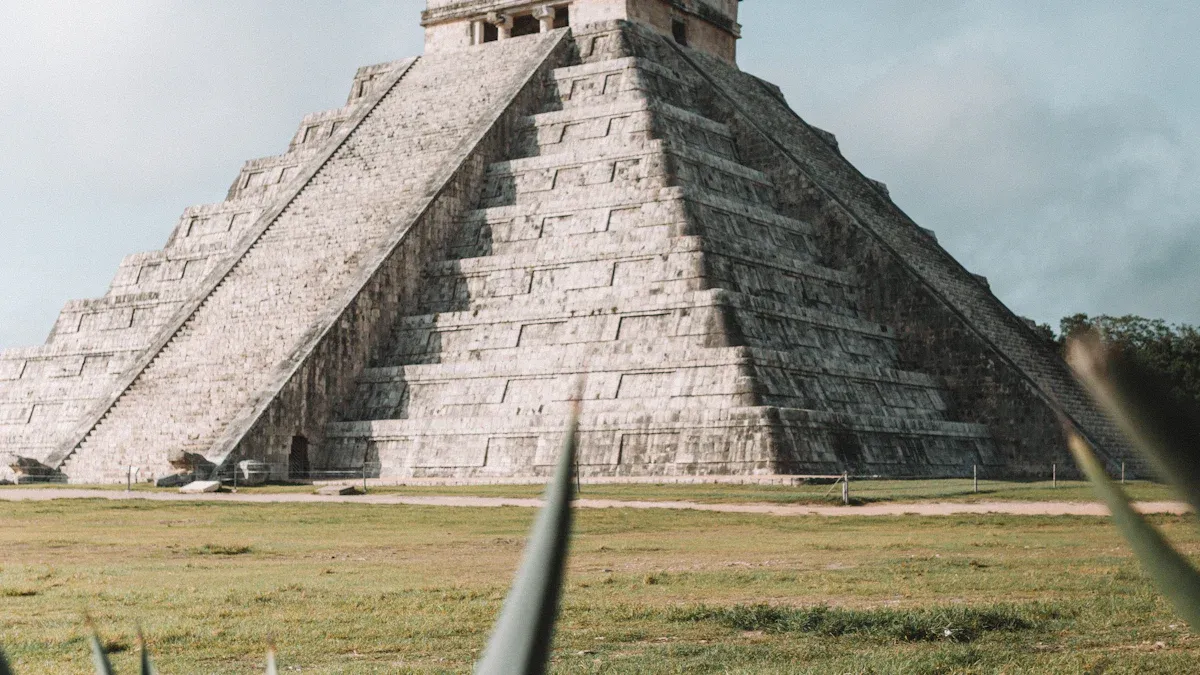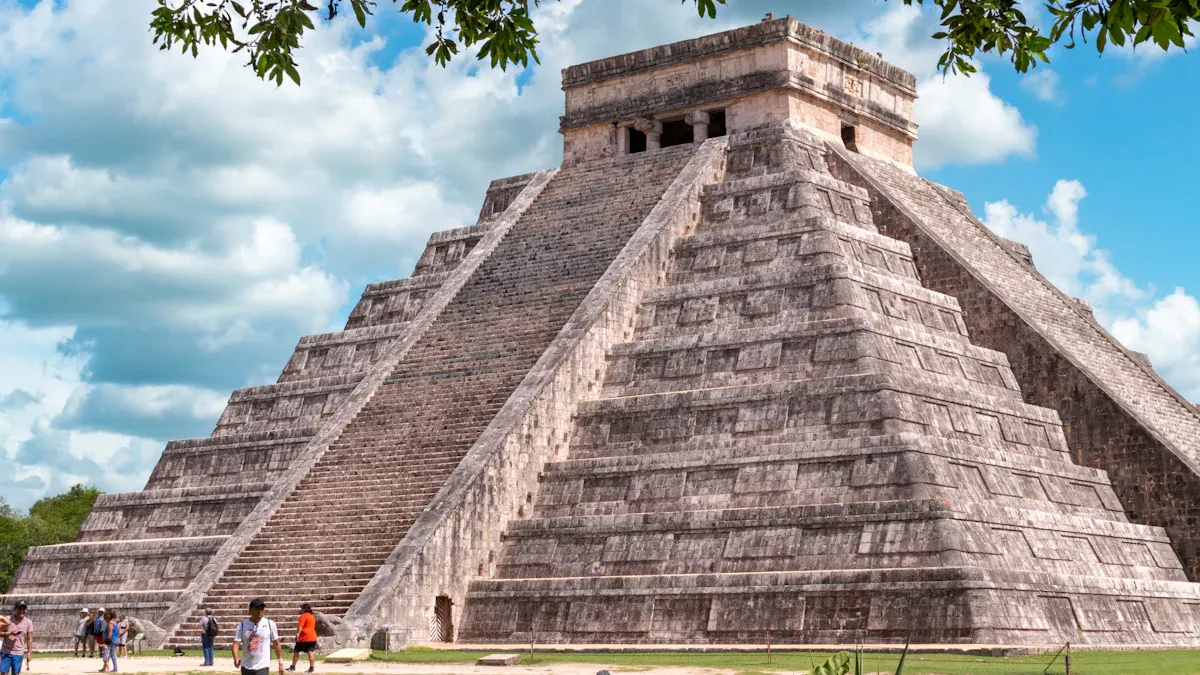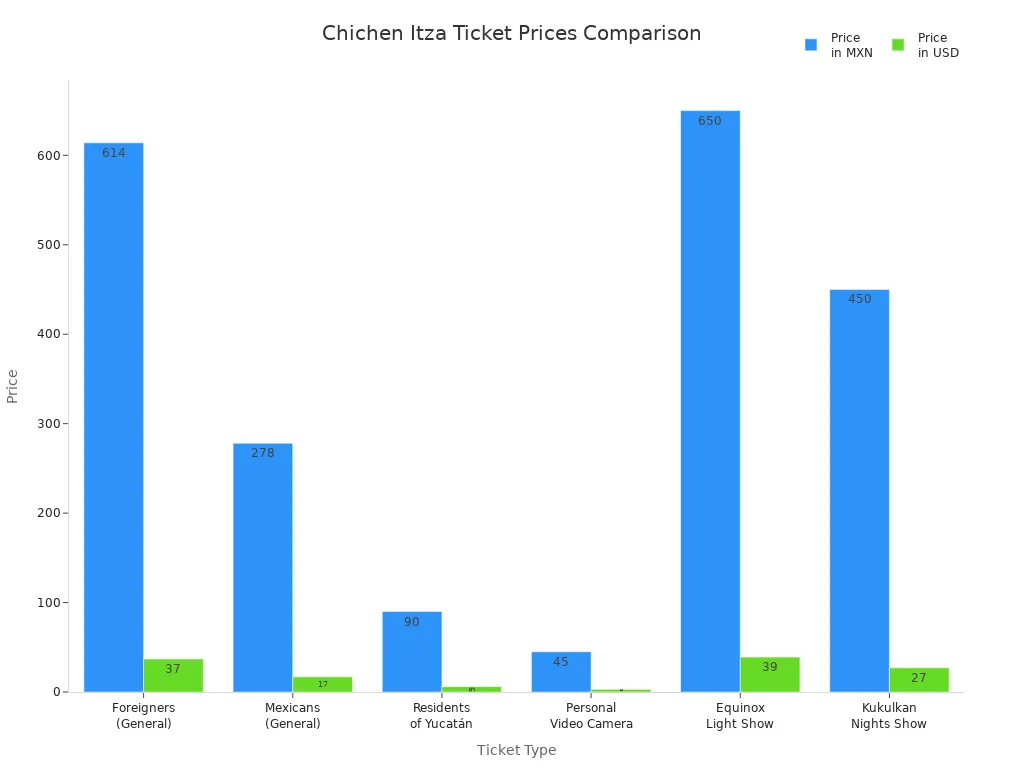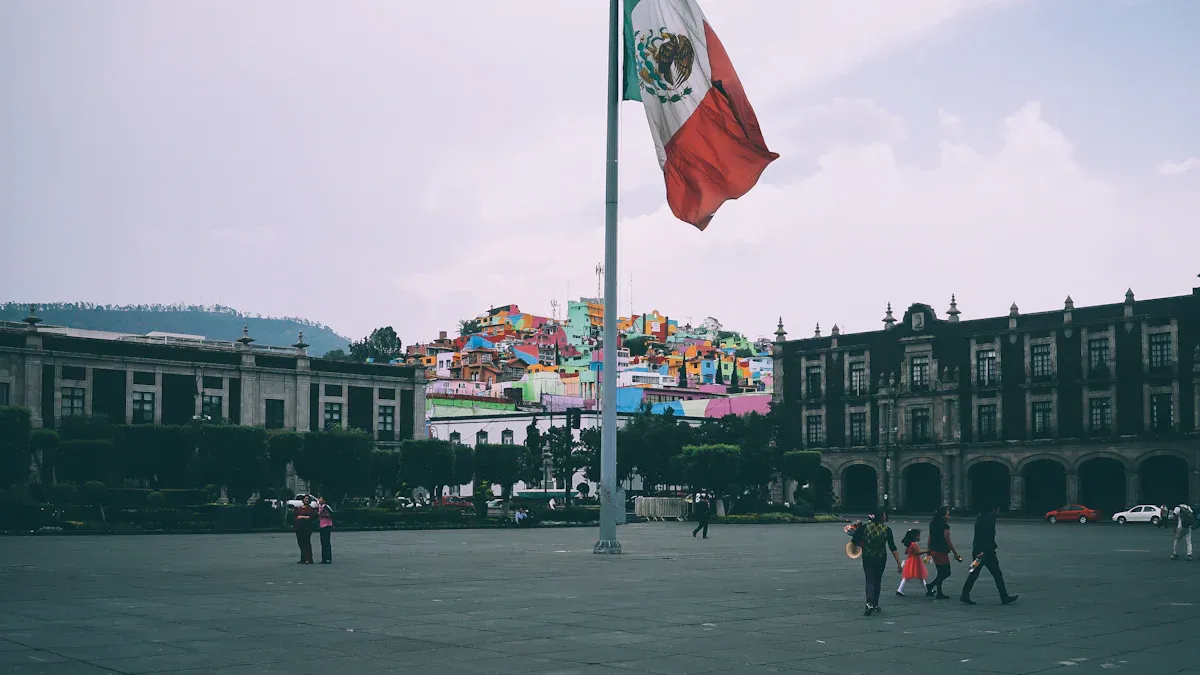- EasyCard
- Trade
- Help
- Announcement
- Academy
- SWIFT Code
- Iban Number
- Referral
- Customer Service
- Blog
- Creator
10 Famous Landmarks in Mexico That Will Inspire Your Next Trip

Image Source: unsplash
You probably dream of seeing the top ten landmarks that make Mexico famous for its rich culture and stunning scenery. These famous landmarks include Chichen Itza, Monte Alban, the Great Pyramid of Cholula, Tulum, Palenque, El Tajin, Museo Nacional de Antropología, El Zócalo, Museo Subacuático de Arte, and Mexico City. Millions visit these places each year, drawn by ancient ruins, colorful museums, and breathtaking views. Mexico is famous for vibrant cities, ancient wonders, and unique tourist attractions. You will find these famous landmarks in Mexico packed with history, adventure, and beauty—true top rated places to visit in Mexico. Tulum stands out with its seaside ruins, while Mexico City is famous for world-class museums and lively plazas. Get ready to explore Mexico famous landmarks and discover why Mexico is famous for unforgettable places.
Key Takeaways
- Mexico offers a rich mix of ancient ruins, vibrant cities, and unique attractions that showcase its deep history and culture.
- Plan visits early in the day and during the dry season to enjoy landmarks like Chichen Itza, Teotihuacan, and Tulum with fewer crowds and better weather.
- Many sites provide guided tours and special experiences, such as underwater art at Museo Subacuático de Arte or hot air balloon rides over Teotihuacan, enhancing your adventure.
Chichen Itza

Image Source: unsplash
Overview
Chichen Itza stands as one of the most famous Mayan ruins and a top world heritage site in Mexico. You will find this ancient city in the Yucatán Peninsula, where it served as a major center from AD 600 to 1200. Chichen Itza is a UNESCO World Heritage Site and has earned its place as a New Seven Wonder of the World. The pyramid of Kukulkan, also called El Castillo, is the highlight here. This pyramid has 365 steps, matching the days of the year, showing the Maya’s deep knowledge of astronomy. During the spring and fall equinoxes, you can watch a shadow snake slither down the pyramid’s steps—a magical sight that draws crowds from all over.
Here are some key facts about Chichen Itza’s history:
- Chichen Itza was a major city for the Maya, with a population between 50,000 and 100,000.
- The city covers about 25 square kilometers and features many architectural styles.
- The Sacred Cenote played a big role in religious ceremonies, including offerings to the rain god Chaac.
- The ball court at Chichen Itza is the largest in the Americas.
- Even after people left the city, it stayed important for worship and pilgrimages.
- Chichen Itza is one of the most visited places in Mexico, attracting millions each year.
Visitor Tips
You will want to plan your visit to Chichen Itza for the best experience. The dry season, from November to April, brings pleasant weather and fewer crowds. November, February, and March are especially good months. Try to arrive early, around 8 AM, to beat the heat and the crowds. Weekdays, especially Wednesday and Thursday, are quieter. Avoid Sundays if you can, since locals get free entry and the site gets busy.
Chichen Itza welcomes about 2.28 million visitors each year, with numbers rising thanks to better access like the new Mayan train. For tickets, you can buy them online to skip the line or at the entrance. Here’s a quick look at ticket prices:
| Ticket Type | Price (USD) | Notes |
|---|---|---|
| Foreigners (General Entrance) | 37 | Includes all fees |
| Mexicans (General Entrance) | 17 | Discounted rate |
| Residents of Yucatán | 6 | Special local rate |
| Personal Video Camera Fee | 3 | Extra charge |
| Free Access | N/A | Children under 13, students, teachers, elderly with ID; Sundays free for Mexicans |
| Equinox Nighttime Light Show | 39-42 | Prices vary by day |
| Kukulkan Nights Light Show | 27-42 | Fridays and Saturdays higher price |

Bring cash in USD for small purchases, just in case. Guided tours are available in different languages and can make your visit even more interesting. Don’t forget sunscreen, water, and a hat, since there is little shade around the pyramid and other ruins. Chichen Itza is a world heritage site that will leave you amazed by its history and beauty.
Teotihuacan
Highlights
You will find Teotihuacan just outside Mexico City, and it stands as one of the most impressive ancient places in the world. When you walk through this ancient city, you step into a place that once held over 100,000 people. The city’s layout feels different from other ancient sites in Mexico. Teotihuacan uses a grid system, with the Avenue of the Dead running straight through the center. This wide road connects the main landmarks and shows off the city’s smart planning.
Here are some highlights you should not miss:
- The pyramid of the sun rises about 216 feet high. It is one of the largest pyramids on Earth and was used for rituals tied to the sun and astronomy.
- The pyramid of the moon sits at the end of the Avenue of the Dead. You can climb its first platform for the best views of the city and the surrounding valley.
- The Ciudadela complex holds the Temple of the Feathered Serpent, famous for its carved stone serpent heads.
- You will also see large plazas, apartment compounds, and an advanced water system that kept the city running smoothly.
Teotihuacan’s unique design stands out because it does not have a royal palace or ballcourt like other ancient cities. Instead, you see neighborhoods built around shared courtyards and formal patio-room blocks.
Travel Tips
Start your visit early in the morning. Head first to the pyramid of the moon. Climb to the first platform and enjoy the view before the crowds arrive. After that, walk along the Avenue of the Dead and explore the smaller temples and the Ciudadela. Save the pyramid of the sun for last. The climb is fun, but the view from the moon pyramid is even better.
Bring sunscreen, a hat, and water. The sun can be strong, and there is little shade. Avoid Sundays if you want to skip the crowds, since Mexican residents get free entry that day. You can bring snacks or take a break in the nearby town of San Juan Teotihuacan for lunch.
If you want a special experience, book a hot air balloon ride for a bird’s-eye view of the pyramids. Guided tours are easy to find and can make your visit more interesting. Many tours include stops at other cultural places, transportation, and even tequila tastings. Prices for group tours usually start under $50 USD, and you can find private tours for a higher price if you want a more personal touch.
Monte Alban
History
Monte Alban sits high above the Oaxaca Valley and stands as one of the most important historical sites in mexico. The Zapotec people built this city around 500 BCE on a hilltop that gave them a great view of the land. Over time, Monte Alban grew into a powerful center for politics, culture, and religion. You can see the remains of temples, palaces, and ball courts that show how advanced the Zapotec civilization was.
Here’s a quick look at Monte Alban’s story:
- Zapotec villages joined forces to build Monte Alban on a flat hilltop.
- The city became the heart of Zapotec life, peaking between 200 and 700 CE.
- Builders created huge plazas, temples, and even a ball court for ceremonies.
- The city expanded its power by conquering nearby places and showing this in stone carvings.
- Monte Alban played a big role in early writing and calendar systems in mexico.
- After 700 CE, the city lost power and was later used by the Mixtecs.
- Today, Monte Alban is a UNESCO World Heritage site and a symbol of Zapotec culture.
When you walk through Monte Alban, you step into a place where ancient rulers celebrated victories and honored their ancestors.
Visiting Guide
You can reach Monte Alban easily from Oaxaca City. The site sits about 1,300 feet above the valley, so you get amazing panoramic views of the mountains and valleys below. The best spot for photos is the south platform, where you can see the whole site and the land around it.
Here are some ways to get there:
| Transportation Option | Description | Price (USD) | Notes |
|---|---|---|---|
| Shuttle Bus | Leaves hourly from Oaxaca City, takes about 30-40 minutes | $5-6 round-trip | Buy tickets at the zocalo or online |
| Taxi | Fast and direct, 20-30 minutes | $15 one-way | Good for groups, agree on price first |
| Private Car | Flexible for families or groups | Varies | Best for multi-stop trips |
| Rental Car | Drive yourself, parking available | From $25/day | Useful if visiting other places |
| Walking | 9 km uphill trail | Free | Not recommended for safety reasons |
Tip: Shuttle buses are the most budget-friendly and run every hour. Taxis are easy to find going up, but can be harder to catch for the return trip.
When you visit, wear comfortable shoes and bring water. The sun can be strong, and there is little shade. Monte Alban is one of those places in mexico where you can see both history and nature come together.
Great Pyramid of Cholula
Facts
You might think the Great Pyramid of Cholula looks like a hill, but it is actually one of the most impressive historical sites in mexico. This pyramid holds the record as the largest pyramid by volume in the world. People started building it around 200 BC, and it grew over twelve centuries as different groups added new layers. The pyramid is made from adobe bricks and has a wide base, making it even bigger than the famous pyramids in Egypt.
Here’s a quick look at what makes the Great Pyramid of Cholula stand out:
| Aspect | Details |
|---|---|
| Base Dimensions | Up to 450 x 450 meters (1,476 x 1,476 feet) |
| Volume | About 4.45 million cubic meters |
| Height | 25 to 66 meters (82 to 216 feet) |
| Construction Period | 200 BC to 9th century AD |
| Material | Adobe bricks |
| Appearance | Looks like a natural hill due to overgrowth |
| Cultural Significance | Known as Tlachihualtepetl, or “constructed mountain” |
The Spanish built the Iglesia de Nuestra Señora de los Remedios on top of the pyramid in the 16th century. This church stands as a symbol of how the Spanish tried to replace native beliefs with Christianity. The church also helped keep the pyramid hidden for many years, so the site stayed well-preserved.
How to Visit
You can explore the Great Pyramid of Cholula in a few exciting ways. Start at the archaeological park, where you can enter a tunnel that runs right through the heart of the pyramid. The tunnel is about 1,200 feet long and lets you see the different layers built by ancient people. Guided tours help you understand how the pyramid grew over time.
Here’s how you can make the most of your visit:
- Walk through the tunnels to see the pyramid’s inner structure and learn about its history.
- Stop by the small museum near the entrance. The museum has models and displays that show how the pyramid was built.
- Climb up to the church on top. From there, you get amazing views of the city, the Valley of Puebla, and even nearby volcanoes.
- Enjoy the local vendors and cultural performances around the site.
The tunnels are not crowded, so you can take your time and really enjoy this unique experience. The Great Pyramid of Cholula is a must-see if you love exploring the largest pyramids and want to discover the deep history of mexico.
Tulum Ruins
Site Features
You will find the Tulum ruins perched on a dramatic cliff about 12 meters above the turquoise Caribbean Sea. This spot gave the ancient Mayan city a natural defense. Steep sea cliffs protected the eastern side, while a thick stone wall wrapped around the other three sides. The wall stretched about 400 meters and stood up to 5 meters high, with watchtowers at the corners. Five narrow gateways controlled who could enter, making Tulum a true fortress on the coast.
The main pyramid, called El Castillo, stands right on the bluff. You can see the ocean stretch out for miles from here. The beach below once served as a busy dock for Mayan trading canoes. Tulum was a key stop for merchants traveling along the Yucatán Peninsula. The ruins are smaller than other ancient mayan ruins in mexico, but you will spot well-preserved buildings like the Temple of the Frescoes. Some murals and carvings still remain, giving you a glimpse into the past.
Tulum ruins are not as large or restored as Chichen Itza, but the seaside setting makes them unforgettable.
Best Time to Go
You should visit the Tulum ruins early in the morning. The light is soft, the crowds are thin, and the temperature feels pleasant. November to April brings the best weather, with less rain and cooler air. If you want to avoid the busiest days, skip weekends and holidays.
After exploring the ruins, you can walk down to the nearby beaches. The white sand and clear water invite you to relax or swim. Many travelers combine a trip to the Tulum ruins with a beach day or even snorkeling. You can also visit the town of Tulum for fresh food and local shops. This mix of history and nature makes Tulum one of the most inspiring places to visit in mexico.
Palenque
Main Attractions
You will find Palenque deep in the jungle, making it one of the most magical places in mexico. The ancient city stands out for its beautiful Mayan architecture and mysterious vibe. When you walk through the ruins, you will see some of the most famous attractions:
- The Temple of Inscriptions: This pyramid holds the tomb of Pakal the Great. It also has long stone texts that tell the story of Palenque’s rulers.
- The Royal Palace: This large building has many rooms, courtyards, and a tall tower. You can spot painted stucco sculptures and even an old aqueduct system.
- The Group of the Cross temples: These include the Temple of the Sun, the Cross, and the Foliated Cross. They are full of carvings and symbols that honor Palenque’s gods.
- Unique features: Palenque’s builders used corbel arches, fancy roof decorations, and detailed stucco art. Some buildings line up with the sun and stars, showing the Maya’s love for astronomy.
You will notice that the walls and sculptures tell stories about Maya myths and ceremonies. The palace and temples make Palenque a must-see for anyone who loves ancient attractions.
Travel Advice
Palenque’s jungle setting makes your visit feel like a real adventure. The thick forest surrounds the ruins, so you feel like you have stepped into a lost city. You might hear howler monkeys or see colorful birds as you explore. The shade from the trees helps you stay cool, but the air can feel warm and humid. Take your time and enjoy the peaceful sounds of nature.
If you want more adventure, you can join a guided jungle tour. Local guides will lead you through the forest, across streams, and even up small waterfalls. Some tours offer mud baths or let you discover hidden ruins. After exploring the ruins, you can visit nearby waterfalls like Misol-Ha or Agua Azul. These spots are perfect for swimming and relaxing after a day of walking.
You can stay in jungle lodges close to the site. At night, you will fall asleep to the sounds of crickets and monkeys. Palenque gives you a mix of history, nature, and adventure that you will not find at other attractions in mexico.
El Tajin
Unique Aspects
When you visit El Tajin, you step into a city that once stood at the heart of Totonac culture in mexico. The most famous structure here is the Pyramid of the Niches. This pyramid rises about 20 meters and has exactly 365 niches—one for each day of the solar year. The design shows how the ancient builders understood astronomy and used the pyramid as a kind of calendar. You will notice the pyramid’s seven levels and its red and black paint, which made it stand out in its time.
El Tajin was more than just a city. It was a major political and religious center. The Totonac people built advanced water systems and many ball courts, showing their skills in engineering and sports. The city’s monuments, like the Pyramid of the Niches, honored important leaders and connected to the Mesoamerican calendar. Even after the city fell, local people respected and protected the ruins for centuries.
El Tajin is also famous for the Danza de los Voladores, a ritual where dancers spin down from a tall pole. This tradition celebrates the Totonac connection between earth and sky and continues today.
Planning Your Visit
You can visit El Tajin year-round, but the best time is from November to March when the weather feels cooler and drier. If you want to see something special, plan your trip for late March during the Cumbre Tajín festival. This event brings music, dance, and the Danza de los Voladores to life right at the site.
Here are some tips for your visit:
- Arrive early to enjoy the ruins before it gets hot.
- Wear comfortable shoes for walking on uneven ground.
- Bring water and sunscreen, since there is little shade.
- Check out the on-site museum to learn more about Totonac culture.
A trip to El Tajin lets you explore one of mexico’s most mysterious and beautiful ancient cities. You will leave with a deeper understanding of the Totonac people and their amazing achievements.
Museo Nacional de Antropología
Must-See Exhibits
If you visit Mexico City, you cannot miss the Museo Nacional de Antropología. This museum stands as one of the top attractions in the city and draws visitors from all over the world. You will find some of the most important treasures from ancient Mexico here. The museum’s collection covers thousands of years and many cultures.
Here are some must-see exhibits you should look for:
- The Aztec Sun Stone, also called the Aztec Calendar Stone, is huge and full of detailed carvings. It weighs over 24,000 kilograms and measures about 3.5 meters across. Many people come just to see this famous artifact.
- The Olmec colossal heads are giant stone sculptures that date back to at least 900 BCE. These heads show the skill of early artists in Mexico.
- The jade death mask of a Mayan king shines with bright green stones.
- A replica of Moctezuma II’s headdress, made with colorful quetzal feathers and gold thread, stands out in the collection.
- The statue of Xochipilli, the Aztec god of art and dance, shows amazing detail and creativity.
- The Disk of Mictlāntēcutli and the reproduction of the Temple of the Feathered Serpent from Teotihuacan help you imagine life in ancient times.
- The tomb of K’inich Janaab’ Pakal and the El Friso de Placeres stucco frieze add even more to the museum’s rich displays.
The Aztec Calendar Stone sits in the most popular gallery. You will see many people taking photos and learning about the science and art of the Aztecs. This stone helps make the museum a must-see world heritage site in Mexico City.
Visitor Information
You will find the Museo Nacional de Antropología in Chapultepec Park, right in the heart of Mexico City. The museum opens from Tuesday to Sunday, 9:00 AM to 8:00 PM. It closes on Mondays. General admission costs about $5 USD, which is a great deal for such a large collection. Students, teachers, and seniors with ID can enter for free on Sundays.
You can buy tickets at the entrance or online. Guided tours are available in English and Spanish. These tours help you understand the stories behind each artifact. If you want to see everything, plan to spend at least half a day here. The museum is easy to reach by metro or taxi from anywhere in Mexico City. Make sure to bring comfortable shoes because the museum is big and has many halls to explore.
Tip: Arrive early to avoid crowds and get the best views of the most famous exhibits. The museum is a world heritage site that gives you a deep look into the history and culture of Mexico.
El Zócalo

Image Source: pexels
Key Sights
When you visit zocalo, mexico city, you stand in the heart of mexico city. This huge plaza has been the center of life since the days of the Aztecs. You can feel the history all around you. Here’s how El Zócalo became so important:
- The Aztecs built their city, Tenochtitlan, here in the 1300s. The main square was the center of their world.
- After the Spanish arrived in 1521, they rebuilt the area as the new city’s political center.
- In 1812, the plaza got its official name, Plaza de la Constitución, to honor the Spanish Constitution.
- El Zócalo has hosted big national events like Independence Day and presidential inaugurations.
- Today, you see it surrounded by famous buildings, including the Metropolitan Cathedral and National Palace.
You will find many landmarks around zocalo, mexico city. Here’s a quick guide:
| Landmark | Where to Find It | Why Visit? |
|---|---|---|
| Metropolitan Cathedral | North side | Largest cathedral in Latin America, built over Aztec ruins |
| National Palace | East side | Home to the president’s offices and Diego Rivera murals |
| Portal de Mercaderes | West side | Historic arcade with shops and hotels |
| City Government Offices | South side | Local government buildings |
| Templo Mayor | Northeast, nearby | Ruins of the Aztec Great Temple |
Tips for Visitors
You should start your day early at El Zócalo. The square gets busy, especially during festivals or holidays. Wear comfortable shoes because you will walk a lot. Don’t miss the Metropolitan Cathedral. Step inside to see its grand altars and old artwork. Next, visit the National Palace. You can see famous murals by Diego Rivera that tell the story of mexico. If you have time, explore the Templo Mayor museum to learn more about the Aztecs. Bring a camera for photos of the giant Mexican flag waving in the center. El Zócalo is the perfect place to feel the energy of mexico city and see its history come alive.
Museo Subacuático de Arte
Underwater Art
You might not expect to find an art museum under the sea, but that is exactly what you get at the Museo Subacuático de Arte near Cancun and Isla Mujeres. This museum features hundreds of sculptures placed on the ocean floor. British artist Jason deCaires Taylor designed these works to do more than just look beautiful. Each sculpture is made from pH-neutral cement, which means it does not harm the water. The rough surfaces attract coral, sponges, and algae. Over time, these sculptures turn into living reefs. Fish and other marine animals move in, creating a new underwater world.
The museum helps protect natural reefs in mexico. By drawing visitors to the sculptures, it gives the natural coral a break from heavy tourist traffic. The human shapes in the art make you feel connected to the ocean. As you swim by, you see how art and nature work together. The museum also teaches you about the importance of ocean conservation and how fragile marine life can be.
The Museo Subacuático de Arte blends creativity with science, turning art into a home for sea creatures and a lesson in protecting our oceans.
How to Experience
You can explore this underwater museum in several ways. If you like snorkeling, you can float above the sculptures and watch fish dart in and out. Many tour companies offer snorkeling trips with guides who explain the art and the marine life you see. If you want to get closer, try scuba diving. Divers can swim right up to the sculptures and see the details up close.
- Snorkeling tours are great for beginners and families.
- Scuba diving lets you explore deeper galleries and see more marine life.
- Glass-bottom boat tours are perfect if you want to stay dry but still enjoy the view.
Most tours leave from Cancun or Isla Mujeres. You can choose half-day or full-day trips, and prices usually start around $50 USD. The museum welcomes both new and experienced swimmers. No matter how you visit, you help support marine conservation in mexico by choosing this unique adventure.
You can plan your next adventure to see these famous landmarks in Mexico. Each site lets you step into history, from ancient pyramids to vibrant city plazas. Exploring mexico famous landmarks helps you understand the country’s culture, traditions, and stories. Share your favorite famous landmarks or travel dreams in the comments!
FAQ
What is the best way to travel between these landmarks?
You can use buses, rental cars, or guided tours. Buses work well for cities. Rental cars give you more freedom for remote sites.
Do I need to buy tickets in advance for popular sites?
Buying tickets online helps you skip lines at busy places like Chichen Itza or Teotihuacan. Some sites sell out during holidays or festivals.
Can I visit these landmarks with kids?
Yes, most sites welcome families. Bring water, snacks, and hats for comfort. Some museums and ruins offer special activities for children.
Exploring Mexico’s iconic landmarks like Chichen Itza, Tulum, and the Museo Subacuático de Arte is an unforgettable journey, but managing travel expenses can be daunting with high transaction fees and fluctuating exchange rates. Whether you’re booking tours, paying for museum tickets, or dining in vibrant Mexico City, BiyaPay simplifies your payments with the Biya EasyCard. This virtual card supports seamless transactions across 190+ countries in 40 local currencies, perfect for covering entrance fees or snorkeling tours with fees as low as 0.5%. The BiyaPay app enhances your travel budget with real-time exchange rate queries for 30+ fiat and 200+ cryptocurrencies, ensuring transparent conversions without hidden costs. Register in minutes to streamline your travel expenses, from pyramid visits to local markets. Start your Mexican adventure with confidence—join BiyaPay today for secure, cost-effective payments that let you focus on the journey.
*This article is provided for general information purposes and does not constitute legal, tax or other professional advice from BiyaPay or its subsidiaries and its affiliates, and it is not intended as a substitute for obtaining advice from a financial advisor or any other professional.
We make no representations, warranties or warranties, express or implied, as to the accuracy, completeness or timeliness of the contents of this publication.




Contact Us
Company and Team
BiyaPay Products
Customer Services
is a broker-dealer registered with the U.S. Securities and Exchange Commission (SEC) (No.: 802-127417), member of the Financial Industry Regulatory Authority (FINRA) (CRD: 325027), member of the Securities Investor Protection Corporation (SIPC), and regulated by FINRA and SEC.
registered with the US Financial Crimes Enforcement Network (FinCEN), as a Money Services Business (MSB), registration number: 31000218637349, and regulated by FinCEN.
registered as Financial Service Provider (FSP number: FSP1007221) in New Zealand, and is a member of the Financial Dispute Resolution Scheme, a New Zealand independent dispute resolution service provider.




















